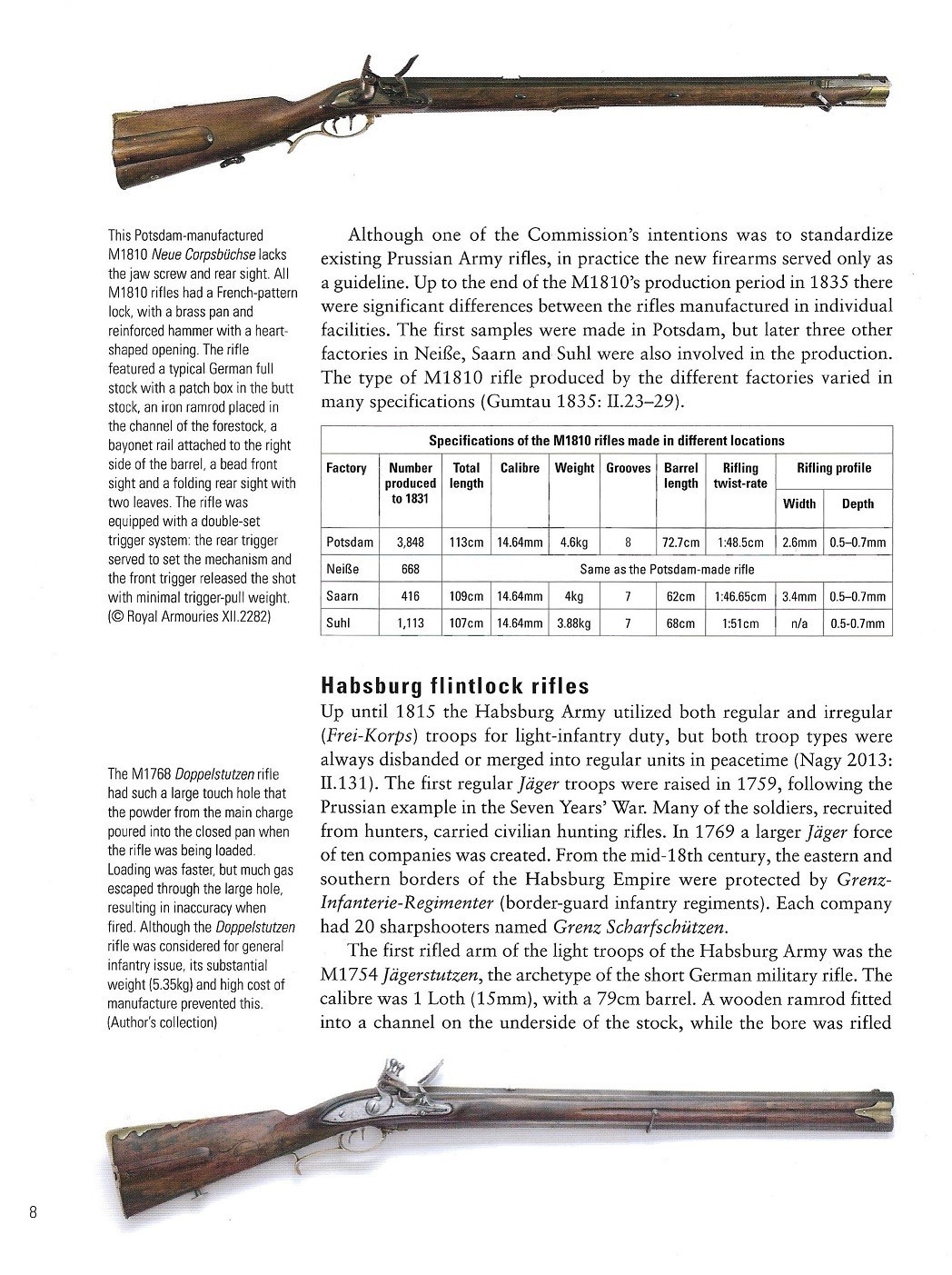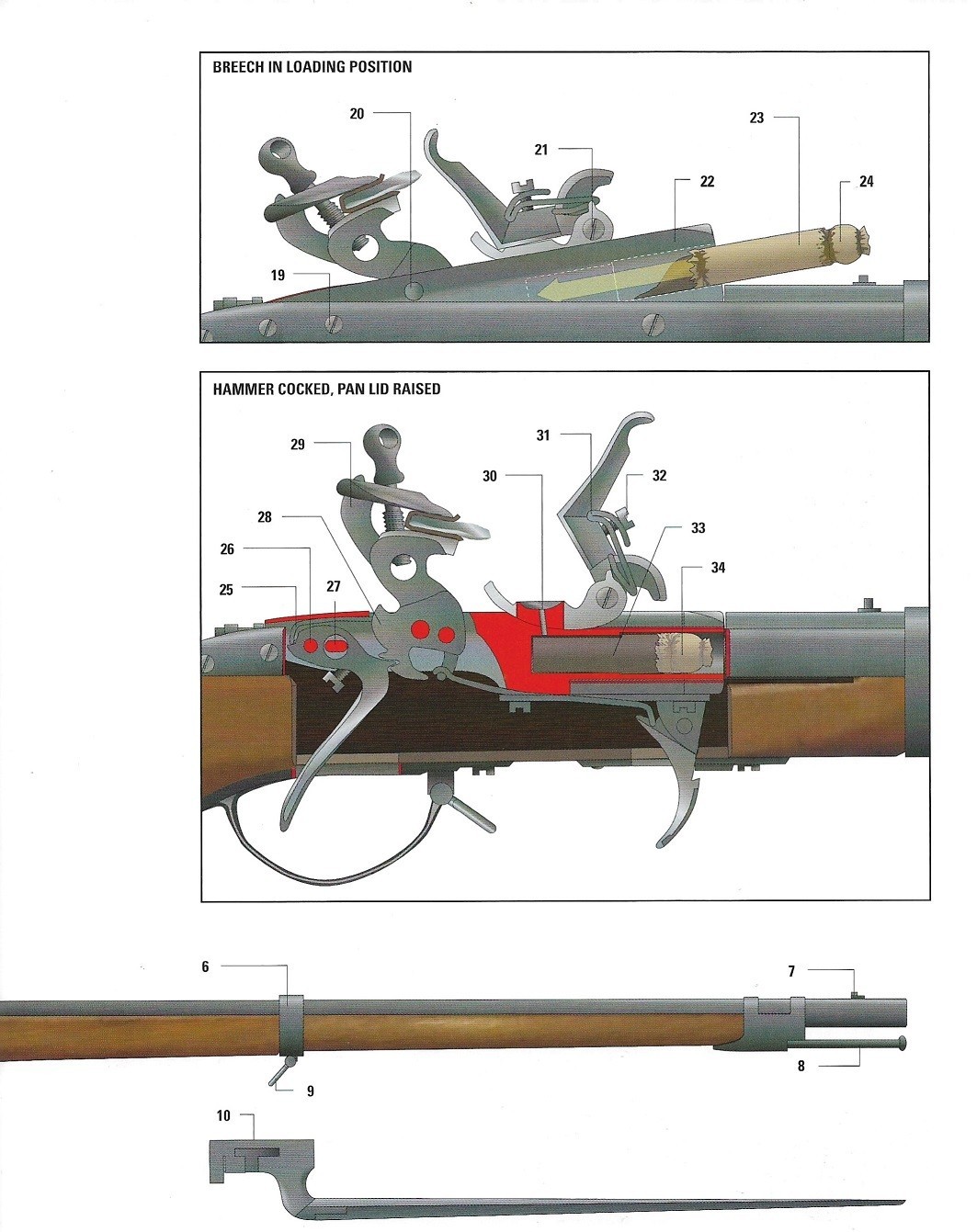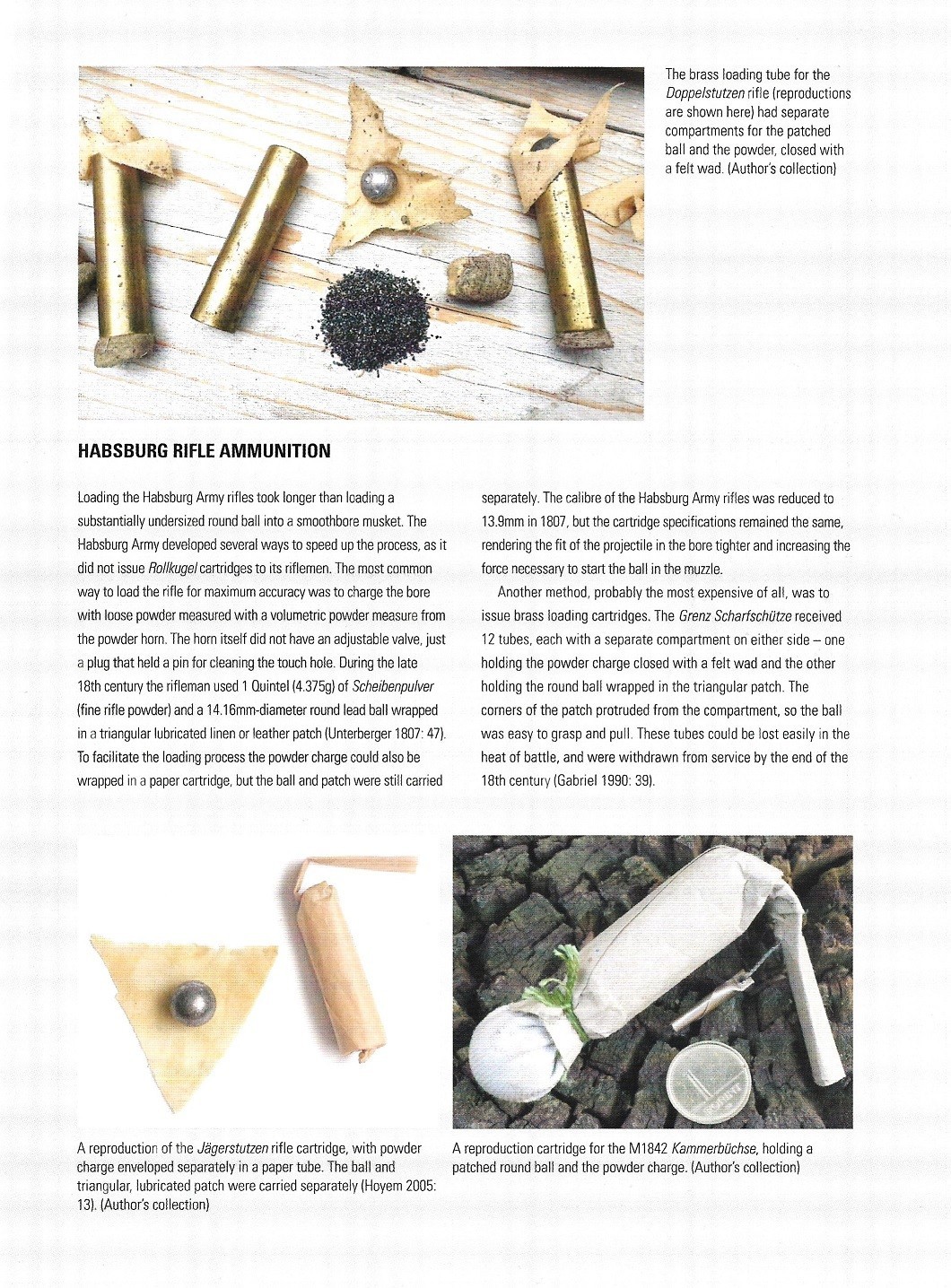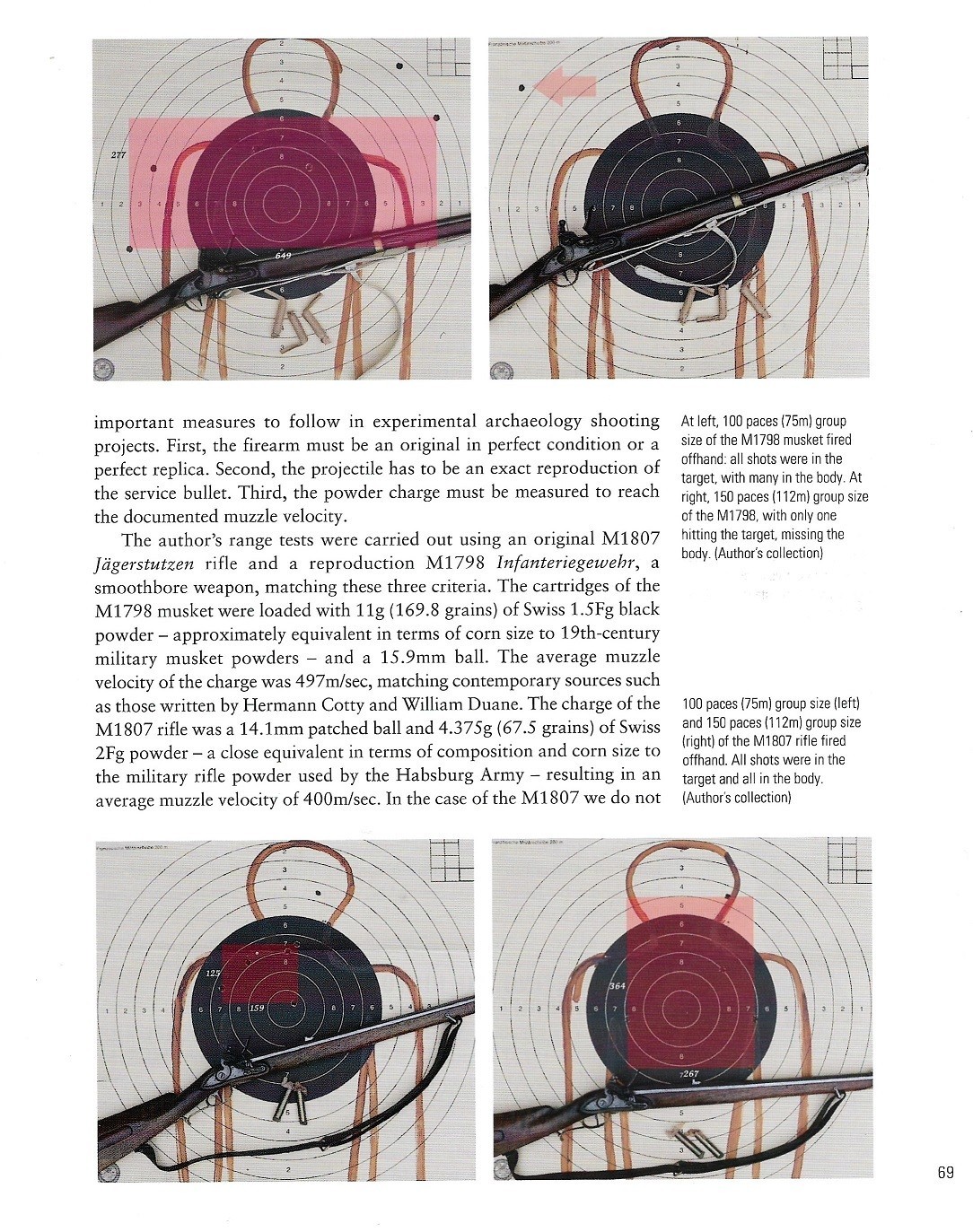HISTORY:
** The conduct of combat operations in open order during the 18th and 19th centuries required an improved firearm with more accuracy that the standard-issue smoothbore infantry musket. Consequently, the appearance of a new type of regular light-infantry soldier and an innovative military firearm, the rifle, opened a new chapter in the history of warfare. During the 18th century both Austria and Prussia fielded light troops armed with rifled firearms, while conflicts in North America involved the deadly long rifle and the innovative Ferguson breech-loader. Rifle-armed specialists also fought for several nations during the Napoleonic Wars. It was the decades after 1815, however, that saw the appearance of successful rifled percussion firearms, paving the way for widespread issue of rifled weapons. This development was accelerated by the Prussian adoption of the Dreyse ‘needle gun’ in 1841 and in 1849, the French Minié rifle was the first successful conical ball rifle concept to be issued to regular troops in large numbers. Illustrated with stunning full-colour artwork, this study charts the development, combat use, influence and legacy of rifled firearms in a host of conflicts, from the War of the Austrian Succession of 1740-48 to the Mexican-American War of 1846-48. **
** Quoted from the back cover of the book.
THE BOOK:
Osprey Publications has released Early Military Rifles, 1740-1850 as Number 76 in their Weapon series. It is a soft cover book with 80 pages. Included with the text are black and white and color photographs, color illustrations, detailed captions and more. It has a 2020 copyright, a publication date of November 26, 2020 and the ISBN is 978-1-4728-4231-2.
THE CONTENTS:
- Introduction
- Development
- The evolving rifle
- Use
- The military art of the rifleman
- Impact
- The early rifles’ performance
- Conclusion
- Bibliography
- Index
THE TEXT:
Author Balázs Németh covers the development, use and impact of British, Prussian, American, French and other countries early military rifles. Several different types of rifles for each country are described in detail as to the year of manufacture, whether there were smooth-bore or rifled weapons (and the comparison of each), the calibers, their successes, failures, shortcoming, attributes, improvements made to the weapons, training the riflemen went through such as target practice, etc. In addition to describing the various rifles and their place in history the author also describes various battles where particular rifles were used and their performance or lack there of a during the fighting. Another area covered by the author is the various types of ammunition used and changes made to the ammunition as well as the types of gunpowder used. Author Balázs Németh goes into detail explaining the process for loading the different weapons, preparing them to fire, firing and then reloading and maintenance of the weapons after use. A section I found to be interesting is the listing of the Habsburg rifle tactics for operating the Doppelstutzen rifle. The tactics were 21 separate steps for loading and aiming the rifle. When reading them the reader can definitely assume that the steps listed were practical for training purposes but more than likely were discarded on the battlefield. In stark contrast to the 21 Habsburg steps, the American 8 step loading process is detailed as well. In addition to his own words the author included personal quotes for members of the various countries militaries as well as excerpts from military publications of the period. The text in the book is nicely written and well detailed. As I read through the text, I didn’t notice any spelling errors but I did take note of a few or grammatical errors throughout the book. One was on page 17 and it was in describing the cost of a rifle and the text stated “$16.32 in the 1830”. Another was on page 47 and it was in the describing of casting bullets and it states “cutting the sprue of the bullets”. It should be “off” and not “of”. Grammar and spelling might not be an important factor to everyone however it is something that I take notice of and pass on my findings. I feel that if the text is well written then it shows that the author has taken the time to be professional with their writing. The grammatical errors I did find are minor but I figured they should be mentioned. I feel that author Balázs Németh did an excellent job of discussing the various militaries weapons from their introduction though to the end of their service. Anyone wanting to add an excellent reference and history book on early military rifles used by militaries around the world during the time frame of 1740 through 1850 to their personal library will be pleased with this very informative and interesting book.
THE PHOTOGRAPHS:
A total of 9 black and white photographs and 87 color photographs are included in this volume. I would say that the historical photographs that were chosen for this book were for the most part lesser-known photographs as opposed to photographs that are featured in many other titles that deal with the same subject matter. The photographs range from wide angle photographs to close-up detailed photographs. I appreciate the fact that there are several photographs of just the weapons and specific parts of the rifles themselves as opposed to photographs that feature the weapons in a broad generalized military photograph. In my opinion it makes it much easier to study the various weapons and their details. In addition to the various military rifles detailed there are also up-close photographs of various bayonets, loading tubes, ammunition, percussion caps, powder horns, practice targets and other such items. As well as showing the various rifles and their accessories the photographs of period illustrations also provide excellent details of various countries military uniforms. Author Balázs Németh stuck to the title of the book and chose subject specific photographs and did not include photographs that strayed from the main subject of the book. The majority, if not all, of the photographs will prove to be a wealth of information to anyone interested in military rifles of various countries during the historical timeframe of 1740 through 1850 due to the details they contain.
Some of the various military rifles shown are:
- Prussian Alte Corpsbüchse
- M1787 Schützengewehr
- Harper’s Ferry M1803 flintlock rifle
- M1819 Hall rifle
- M1841 Dreyse Zündnadelgewehr
- M1841 ‘Mississippi’ rifle
THE ILLUSTRATIONS:
There are 5 color illustrations by illustrators Johnny Shumate and Alan Gilliland. The illustrations are very well done, nicely detailed and are of:
Plate A
The M1819 Hall Rifle Exposed
Three cut-away views showing the internal workings of the .525-calibre Harper’s Ferry M1819 Hall flintlock rifle. Also provided is a key which details 34 specific items that are pointed out on the M1819 Hall Rifle.
Plate B
The Kammerbüchse Revealed
Three cut-away views showing the internal workings of the 18.1mm M1842 Kammerbüchse. Also provided is a key which details 32 specific items that are pointed out on the M1842 Kammerbüchse.
Plate C
Habsburg Army Jäger on skirmish duty, 1809
A one-page action scene depicting a pair of FeldJäger in action against Napoleon’s forces. One man, a Carabiner-Jäger, reloads his M1798 smoothbore musket while the other man, a rifle-armed Stutzen-Jäger is taking aim while kneeling.
Plate D
‘Mississippi’ rifles at the battle of Buena Vista.
A one-page action scene depicting Mississippi riflemen led by Colonel Jefferson Davies, having fired their last volley from their M1841 “Mississippi’ rifles, attacking the charging Mexican cavalry on February 23, 1847. Many of the ‘Mississippi’ riflemen, having dropped their rifles, are attacking with their drawn Bowie knives.
Plate E
Rifles at Kings Mountain, 7 October 1780.
A two-page action illustration depicting the engagement between William Campbell’s Patriot backwoodsmen and captain Partick Ferguson’s Loyalist militia at King’s Mountain, South Carolina.
THE CAPTIONS:
The captions are well written and explain the accompanying photographs and illustrations in great detail eliminating any doubt as to what is shown. The captions go into very specific detail as to the specific rifles shown, country of origin and model year, associated equipment carried and used, numbers produced, specific items of interest shown, and other such pertinent information. Balázs Németh’s captions are very helpful to the reader due to their detailed content as opposed to other captions that I have seen that are very brief and lacking in detail. I did find a couple of errors in two of the captions. On page 11 the caption doesn’t explain what the air pump and spare magazine/butt are. The reader has to figure out what they are from their reading of the main text. On page 47 there are four pictures of related rifle accessories such as a powder horn and bayonets. One of the pictures features a powder measure and what I believe it is a bullet/ball remover and the caption describes the powder measure shown but does not identify or detail the bullet/ball remover. Other than those two issues I didn’t see anything else. They are minor but I figured they should be mentioned.
NOTES:
There are 2 notes included in this volume and they are:
- Acknowledgements
- Editor’s Note
INFORMATIONAL CHARTS:
There are 4 informational charts included in this volume and they are of:
- Abbreviations (military)
- Common units of measure 1816-40
- Specification of the M1810 rifles made in different locations
- Accuracy of the Alte CorpsBüchse with Pflasterkugel and Patronenkugel cartridges
Osprey Publishing also offers Early Military Rifles, 1740-1850 as:
eBook (ePub) ISBN: 978-1-4728-4232-9
and
eBook (PDF) ISBN: 978-1-4728-4229-9
Osprey Publishing’s, Early Military Rifles, 1740-1850 is also available as a Kindle version through Amazon.
PRICE:
UK £13.99 / US $22.00 / CAN $30.00
This book was provided to me by Osprey Publishing. Please be sure to mention that you saw the book reviewed here on the KitMaker Network when you make your purchase. Thank you.
































